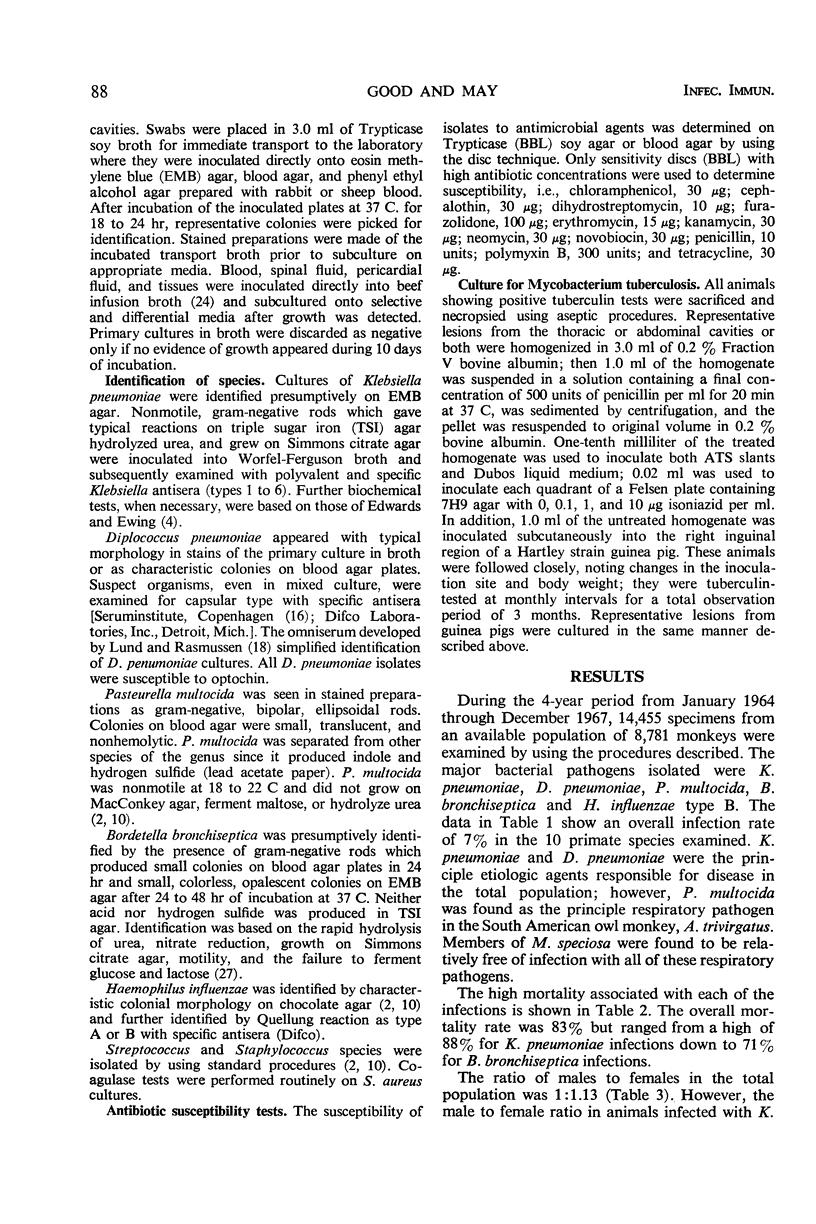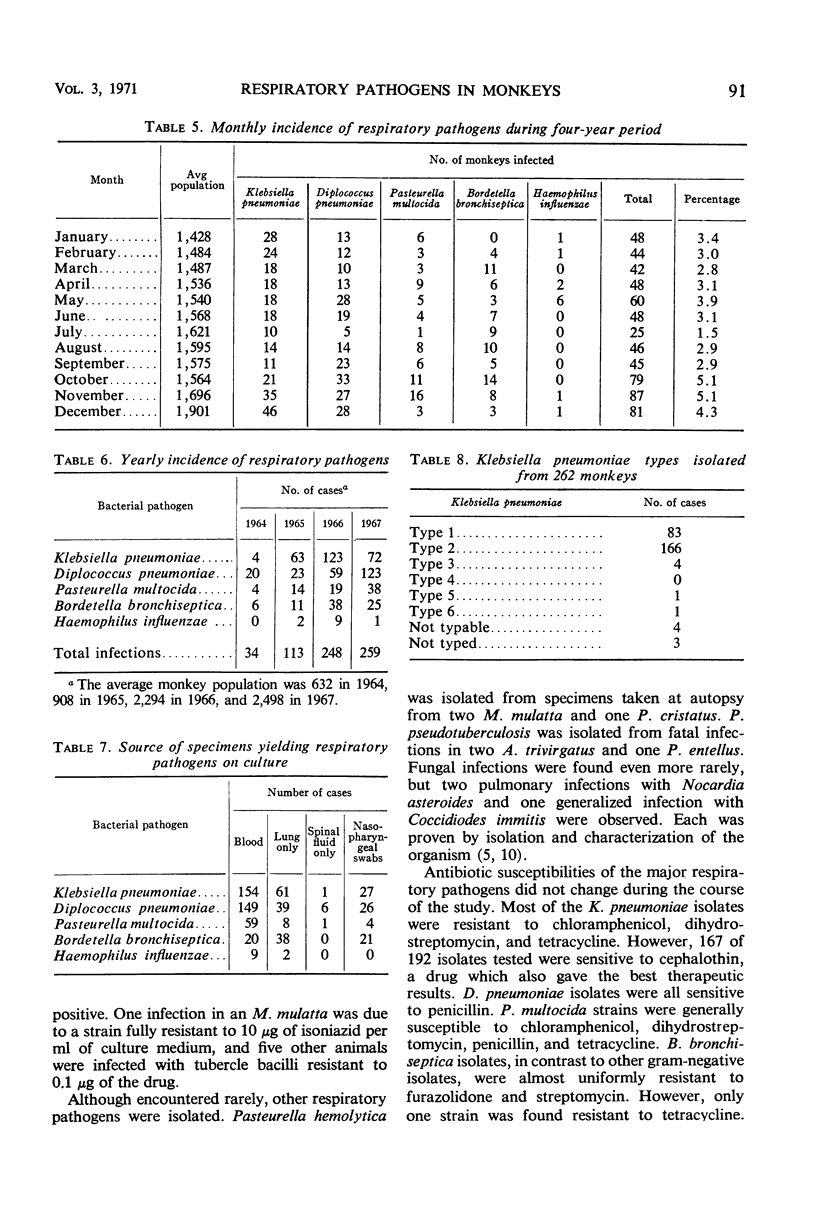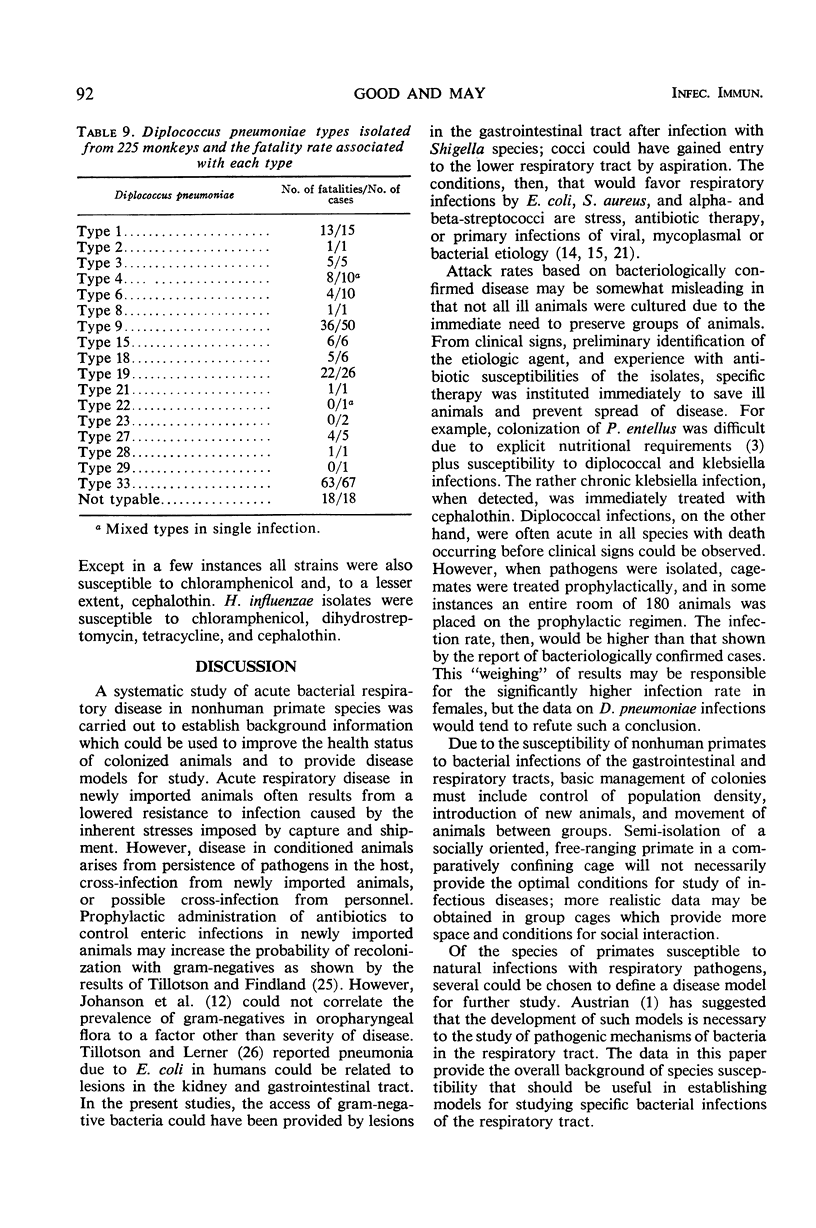Abstract
Respiratory disease in a dynamic colony of nonhuman primates during a 4-year period was due primarily to infections caused by Klebsiella pneumoniae, Diplococcus pneumoniae, Bordetella bronchiseptica, Pasteurella multocida, and Haemophilus influenzae. The principal secondary invaders were Escherichia coli, Staphylococcus aureus, and streptococci. A high fatality rate was associated with infections caused by each of the primary pathogens, and females appeared to be more susceptible than males. Incidence of respiratory disease was greatest in the fall and early winter; however, at all times newly colonized monkeys had a higher infection rate than conditioned monkeys. Infections were occasionally confined only to the lungs and were sometimes present without grossly observable lung lesions. The information given on susceptibility of 10 species of nonhuman primates to respiratory infections provides a basis for developing disease models.
Full text
PDF






Selected References
These references are in PubMed. This may not be the complete list of references from this article.
- Austrian R. The bacterial flora of the respiratory tract. Some knowns and unknowns. Yale J Biol Med. 1968 Apr-Jun;40(5-6):400–413. [PMC free article] [PubMed] [Google Scholar]
- Bauchop T., Martucci R. W. Ruminant-like digestion of the langur monkey. Science. 1968 Aug 16;161(3842):698–700. doi: 10.1126/science.161.3842.698. [DOI] [PubMed] [Google Scholar]
- FEGLEY H. C., SAUER R. M. Mass treatment of monkeys with antibacterial substances. Ann N Y Acad Sci. 1960 May 12;85:777–784. doi: 10.1111/j.1749-6632.1960.tb49999.x. [DOI] [PubMed] [Google Scholar]
- GREENSTEIN E. T., DOTY R. W., LOWY K. AN OUTBREAK OF A FULMINATING INFECTIOUS DISEASE IN THE SQUIRREL MONKEY, SAIMIRI SCIUREUS. Lab Anim Care. 1965 Feb;15:74–80. [PubMed] [Google Scholar]
- Good R. C., May B. D., Kawatomari T. Enteric pathogens in monkeys. J Bacteriol. 1969 Mar;97(3):1048–1055. doi: 10.1128/jb.97.3.1048-1055.1969. [DOI] [PMC free article] [PubMed] [Google Scholar]
- Graves I. L. Bordetella bronchiseptica isolated from a fatal case of bronchopnuemonia in an African green monkey. Lab Anim Care. 1968 Jun;18(3):405–406. [PubMed] [Google Scholar]
- Hunt D. E., Pittillo R. F., Deneau G. A., Schabel F. M., Jr, Mellett L. B. Control of an acute Klebsiella pneumoniae infection in a rhesus monkey colony. Lab Anim Care. 1968 Apr;18(2):182–185. [PubMed] [Google Scholar]
- Johanson W. G., Pierce A. K., Sanford J. P. Changing pharyngeal bacterial flora of hospitalized patients. Emergence of gram-negative bacilli. N Engl J Med. 1969 Nov 20;281(21):1137–1140. doi: 10.1056/NEJM196911202812101. [DOI] [PubMed] [Google Scholar]
- Kourany M., Porter J. A., Jr A survey for enteropathogenic bacteria in Panamanian primates. Lab Anim Care. 1969 Jun;19(3):336–341. [PubMed] [Google Scholar]
- LUND E. POLYVALENT, DIAGNOSTIC PNEUMOCOCCUS SERA. Acta Pathol Microbiol Scand. 1963;59:533–536. doi: 10.1111/j.1699-0463.1963.tb01256.x. [DOI] [PubMed] [Google Scholar]
- Lepow M. L., Balassanian N., Emmerich J., Roberts R. B., Rosenthal M. S., Wolinsky E. Interrelationships of viral, mycoplasmal, and bacterial agents in uncomplicated pneumonia. Am Rev Respir Dis. 1968 Apr;97(4):533–545. doi: 10.1164/arrd.1968.97.4.533. [DOI] [PubMed] [Google Scholar]
- Loosli C. G. Synergism between respiratory viruses and bacteria. Yale J Biol Med. 1968 Apr-Jun;40(5-6):522–540. [PMC free article] [PubMed] [Google Scholar]
- Lund E., Rasmussen P. Omni-serum. A diagnostic Pneumococcus serum, reacting with the 82 known types of Pneumococcus. Acta Pathol Microbiol Scand. 1966;68(3):458–460. doi: 10.1111/apm.1966.68.3.458. [DOI] [PubMed] [Google Scholar]
- Palmer A. E., Allen A. M., Tauraso N. M., Shelokov A. Simian hemorrhagic fever. I. Clinical and epizootiologic aspects of an outbreak among quarantined monkeys. Am J Trop Med Hyg. 1968 May;17(3):404–412. [PubMed] [Google Scholar]
- Potter R. T., Rotman F., Fernandez F., McNeill T. M., Chamberlain J. M. The bacteriology of the lower respiratory tract. Bronchoscopic study of 100 clinical cases. Am Rev Respir Dis. 1968 Jun;97(6):1051–1061. doi: 10.1164/arrd.1968.97.6P1.1051. [DOI] [PubMed] [Google Scholar]
- SAUER R. M., FEGLEY H. C. The roles of infectious and non-infectious diseases in monkey health. Ann N Y Acad Sci. 1960 May 12;85:866–888. doi: 10.1111/j.1749-6632.1960.tb50009.x. [DOI] [PubMed] [Google Scholar]
- Tillotson J. R., Finland M. Bacterial colonization and clinical superinfection of the respiratory tract complicating antibiotic treatment of pneumonia. J Infect Dis. 1969 Jun;119(6):597–624. doi: 10.1093/infdis/119.6.597. [DOI] [PubMed] [Google Scholar]
- Tillotson J. R., Lerner A. M. Characteristics of pneumonias caused by Escherichia coli. N Engl J Med. 1967 Jul 20;277(3):115–122. doi: 10.1056/NEJM196707202770302. [DOI] [PubMed] [Google Scholar]


